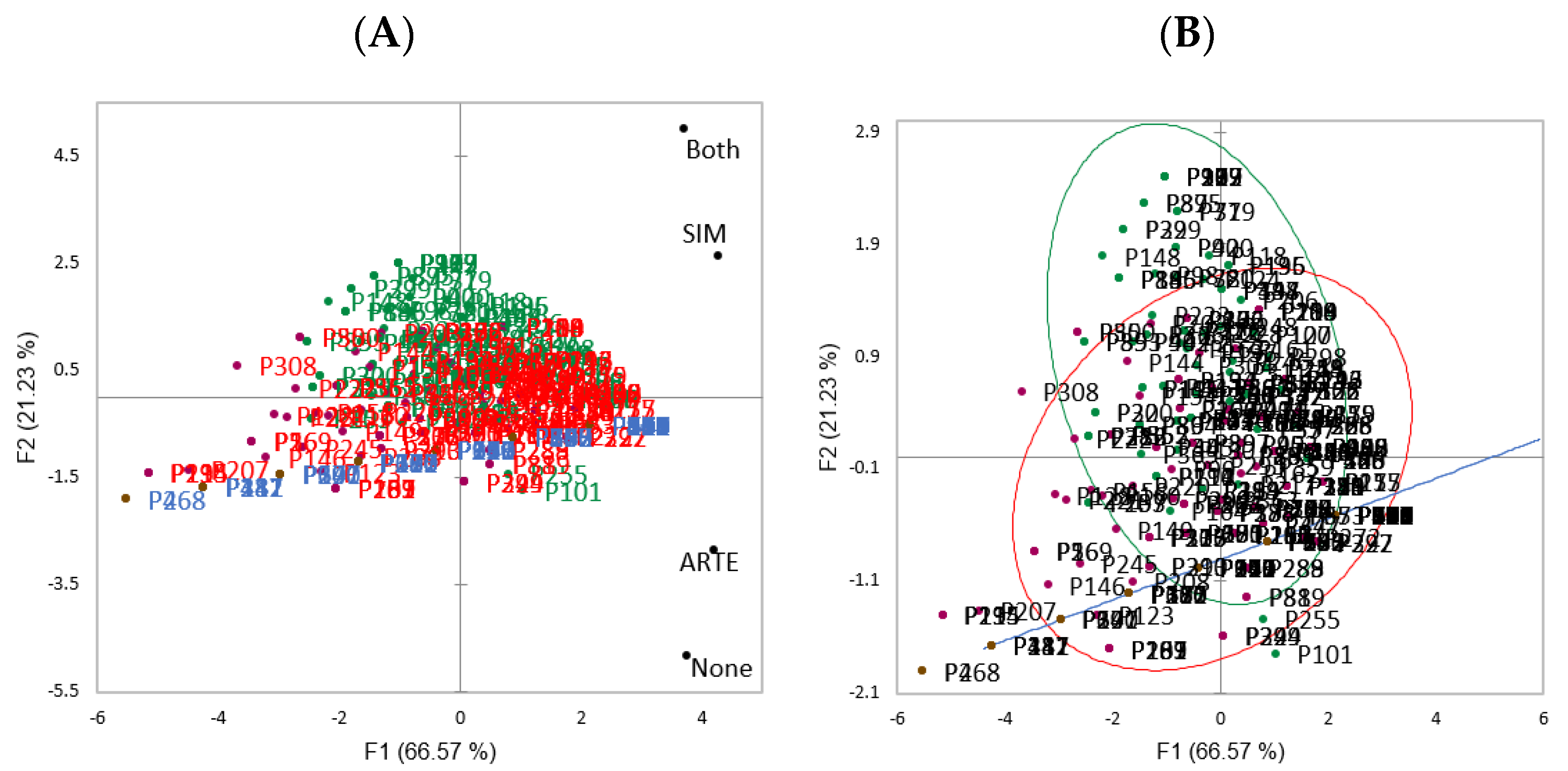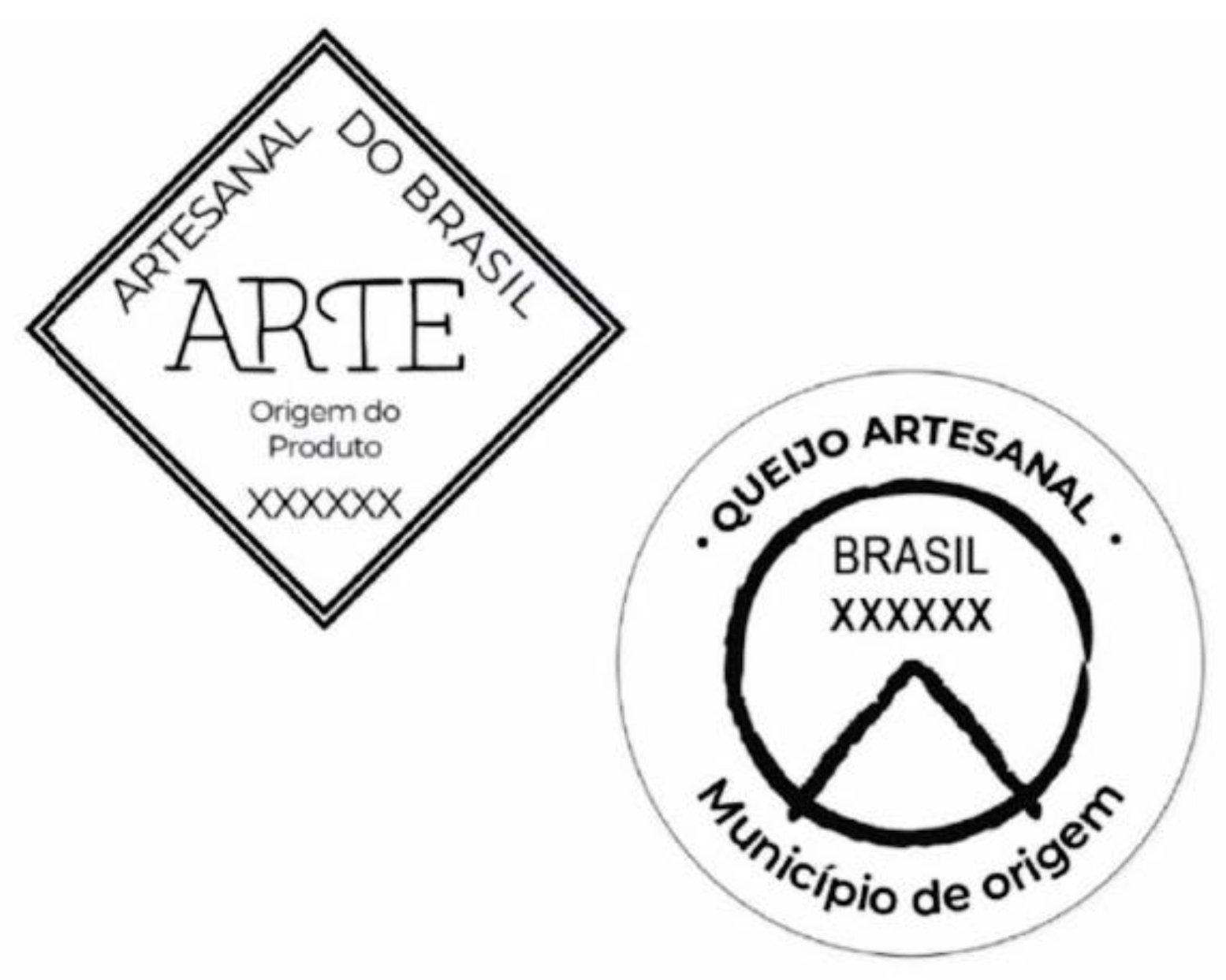Consumers’ Segmentation Influences Acceptance and Preferences of Cheeses with Sanitary Inspection and Artisanal Seals
Abstract
:1. Introductions
2. Literature Review
3. Materials and Methods
3.1. Sampling
3.2. Survey and Product Design
3.3. Data Analysis
4. Results and Discussion
5. Conclusions
Author Contributions
Funding
Institutional Review Board Statement
Data Availability Statement
Conflicts of Interest
References
- Ares, G.; Barreiro, C.; Deliza, R.; Giménez, A.; Gámaro, A. Consumer expectations and perception of chocolate milk desserts enriched with antioxidants. J. Sens. Stud. 2010, 25, 243–260. [Google Scholar] [CrossRef]
- Baldissera, C.; Carlini, N.R.B.S.; Hoppe, A.; Sant’Anna, V. Factors influencing consumers’ attitudes towards the consumption of grape pomace powder. Appl. Food Res. 2022, 2, 100103. [Google Scholar] [CrossRef]
- Baptista, I.; Spence, C.; Shimizu, R.; Ferreira, E.; Behrens, J. Color is to flavor as shape is to texture: A choice-based conjoint study of visual cues on chocolate packaging. J. Sens. Stud. 2022, 38, e12793. [Google Scholar] [CrossRef]
- Grunert, K.G.; Aachmann, K. Consumer reactions to the use of EU quality labels on food products: A review of the literature. Food Control 2016, 59, 178–187. [Google Scholar] [CrossRef]
- Pereira, L.S.; Sant’Anna, V.; Roldan, B.B.; Padilha, R.L. Artisanal and sanitary inspection seals impact on acceptance and emotions of colonial cheese consumption. J. Sens. Stud. 2023, 38, e12821. [Google Scholar] [CrossRef]
- Business Research Insights. Handicrafts-Market-Global-Industry-Trends-Share-Size-Growth-Opportunity-and-Forecast. 2022. Available online: https://www.businessresearchinsights.com/market-reports/handicrafts-market-100147 (accessed on 10 December 2022).
- Available online: https://www.reportlinker.com/p05475137/Handicrafts-Market-Global-Industry-Trends-Share-Size-Growth-Opportunity-and-Forecast.html (accessed on 10 November 2022).
- Rivaroli, S.; Baldi, B.; Spadoni, R. Consumers’ perception of food product craftsmanship: A review of evidence. Food Qual. Prefer. 2020, 79, 103796. [Google Scholar] [CrossRef]
- Ceolin, L.V.; Silva, L.A.B.; Ambrosini, L.B. Queijo Artesanal Serrano nos Campos de Cima da Serra (RS): Análise da dimensão institucional de um Sistema Agroalimentar Localizado. Extensão Rural 2020, 27, 81–99. [Google Scholar] [CrossRef]
- Kimimura, B.A.; Magnani, M.; Luciano, W.A.; Campagnollo, F.B.; Pimentel, T.C.; Alvarenga, V.O.; Pelegrino, B.O.; Cruz, A.G.; Sant’Ana, A.S. Brazilian Artisanal Cheeses: An Overview of their Characteristics, Main Types and Regulatory Aspects. Compr. Rev. Food Sci. Food Saf. 2019, 18, 1636–1657. [Google Scholar] [CrossRef]
- Pretto, A.N.; Sant’Anna, V. Serrano cheese: A cultural, quality and legal view. Rev. Vigilância Sanitária Debate Soc. Ciência E Tecnol. 2017, 5, 81–87. [Google Scholar] [CrossRef]
- Brasil. Congresso Nacional. In Inspeção de Processos de Produtos de Origem Animal Produzidos Artesanalmente; Lei nº 13680; Diário Oficial da União: Brasília, Brazil, 2018; p. 2. Available online: http://www.planalto.gov.br/ccivil_03/_ato2015-2018/2018/Lei/L13680.htm (accessed on 23 February 2022).
- Brasil. Ministério da Agricultura e Pecuária e Abastecimento. In Estabelece Requisitos Para Concessão dos Selos ARTE e Queijo Artesanal Pelos Órgãos de Agricultura e Pecuária Federal, Estaduais, Municipais e Distrital; Define os Padrões de Numeração de Logotipos dos Selos de Identificação Artesanal; e Institui o Manual de Auditoria do Processo de Concessão de Selos de Identificação Artesanal; Portaria Mapa nº 531; Diário Oficial da União: Brasília, Brazil, 2022. Available online: https://www.in.gov.br/web/dou/-/portaria-mapa-n-531-de-16-de-dezembro-de-2022-451621548 (accessed on 16 December 2022).
- Al-Khusaibi, M.; Al-Habsi, N.; Shafiur Rahman, M. (Eds.) Traditional Foods; Food Engineering Series; Springer: Berlin/Heidelberg, Germany, 2019. [Google Scholar] [CrossRef]
- De Freitas, R.S.G.; Stedefeldt, E. Hygiene and humanization: Breaking the traditional view of food safety. Food Res. Int. 2020, 131, 108944. [Google Scholar] [CrossRef]
- Hermann, M. The impact of the European Novel Food Regulation on trade and food innovation based on traditional plant foods from developing countries. Food Policy 2009, 34, 499–507. [Google Scholar] [CrossRef]
- Waldman, K.B.; Kerr, J.M. Does safety information influence consumers’ preferences for controversial food products? Food Qual. Prefer. 2018, 64, 56–65. [Google Scholar] [CrossRef]
- Ueland, Ø.; Gunnlaugsdottir, H.; Holm, F.; Kalogeras, N.; Leino, O.; Luteijn, J.M.; Magnússon, S.H.; Odekrken, G.; Pohjola, M.V.; Tijhuis, M.J.; et al. State of the art in benefit–risk analysis: Consumer perception. Food Chem. Toxicol. 2012, 50, 67–76. [Google Scholar] [CrossRef] [PubMed]
- Sampalean, N.I.; de-Magistris, T.; Rama, D. Investigating Italian Consumer Preferences for Di_erent Characteristics of Provolone Valpadana Using the Conjoint Analysis Approach. Foods 2020, 9, 1730. [Google Scholar] [CrossRef] [PubMed]
- Skubic, M.R.; Erjavec, K.; Klopčič, M. Consumer preferences regarding national and EU quality labels for cheese, ham and honey. Br. Food J. 2018, 120, 650–664. [Google Scholar] [CrossRef]
- Di Monaco, R.; Cavella, S.; Di Marzo, S.; Mais, P. The effect of expectations generated by brand name on the acceptability of dried semolina pasta. Food Qual. Prefer. 2004, 15, 429–437. [Google Scholar] [CrossRef]
- Fiske, S.T.; Taylor, S.E. Social Cognition: From Brains to Culture, 4th ed.; SAGE Publications Ltd.: Thousand Oaks, CA, USA, 2021; 672p, Available online: https://us.sagepub.com/en-us/sam/social-cognition/book269580 (accessed on 16 December 2022).
- Stoner, J.L.; Rodas, M.A. Love is blind: The ironic effect of fans’ experience on taste perception. Mark. Lett. 2023. [Google Scholar] [CrossRef]
- Schröck, R. Valuing country of origin and organic claim. Br. Food J. 2014, 116, 1070–1091. [Google Scholar] [CrossRef]
- Schouteten, J.J.; De Steur, H.; De Pelsmaeker, S.; Lagast, S.; De Bourdeaudhuij, I.; Gellynck, X. Impact of Health Labels on Flavor Perception and Emotional Profiling: A Consumer Study on Cheese. Nutrients 2015, 7, 10251–10268. [Google Scholar] [CrossRef]
- Dominick, S.R.; Fullerton, C.; Widmar, N.J.O.; Wang, H. Consumer Associations with the “All Natural” Food Label. J. Food Prod. Mark. 2017, 24, 249–262. [Google Scholar] [CrossRef]
- Miloradovic, Z.; Blazic, M.; Barukcic, I.; Furnols, M.F.; Smigic, N.; Tomasevic, I.; Miocinovic, J. Serbian, Croatian and Spanish consumers’ beliefs towards artisan cheese. Br. Food J. 2022, 124, 3257–3273. [Google Scholar] [CrossRef]
- Fagnani, R.; Eleodoro, J.I.; Zanon, E.O. Milk-borne infections awareness and the health status of consumers: An on-line survey. Int. Dairy J. 2019, 96, 85–92. [Google Scholar] [CrossRef]
- Steinbach, J.; Fonseca Burgardt, V.D.C.; Castro-Cislaghi, F.P.; Machado-Lunkes, A.; Marchi, J.F.; Prado, N.V.; Mitterer-Daltoé, M.L. Understanding consumer, consumption, and regional products: A case study on traditional colonial-type cheese from Brazil. Int. J. Gastron. Food Sci. 2021, 26, 100418. [Google Scholar] [CrossRef]
- Rodrigues, J.F.; Siman, I.B.; Oliveira, L.E.A.; Fátima Barcelos, A.; Oliveira, R.A.A.; Silva, R.; da Cruz, A.G. Use of diaries as a research strategy on sensory perception and consumer behavior of Canastra cheese. J. Sens. Stud. 2021, 36, 12627. [Google Scholar] [CrossRef]
- Ambrosini, L.B.; Kroeff, D.R.; Matte, A.; Cruz, F.T.; Waquil, P.D. Flavor, history and local economy: Perceptions of gaucho consumers about Colonial Cheese. Pesqui. Agropecuária Gaúcha 2020, 26, 201–221. [Google Scholar] [CrossRef]
- Judacewski, P.; Los, P.R.; Lima, L.S.; Alberti, A.; Zielinski, A.A.F.; Nogueira, A. Perceptions of Brazilian consumers regarding white mould surface-ripened cheese using free word association. Int. J. Dairy Sci. 2019, 72, 585–590. [Google Scholar] [CrossRef]
- Bisconsin-Júnior, A.; Rodrigues, H.; Behrens, J.H.; Lima, V.S.; da Silva, M.A.A.P.; de Oliveira, M.S.R.; Januário, L.A.; Deliza, R.; Netto, F.M.; Mariutti, L.R.B. Examining the role of regional culture and geographical distances on the representation of unfamiliar foods in a continental-size country. Food Qual. Prefer. 2019, 79, 103779. [Google Scholar] [CrossRef]
- Hair, J.F., Jr.; Black, W.C.; Babin, B.J.; Anderson, R.E. Multivariate Data Analysis, 7th ed.; Prentice Hall: Upper Saddle River, NJ, USA, 2010. [Google Scholar]
- Abouab, N.; Gomez, P. Human contact imagined during the production process increases food naturalness perceptions. Appetite 2015, 91, 273–277. [Google Scholar] [CrossRef]
- Autio, M.; Collins, R.; Wahlen, S.; Anttila, M. Consuming nostalgia? The appreciation of authenticity in local food production. Int. J. Consum. Stud. 2013, 37, 564–568. [Google Scholar] [CrossRef]
- Cunha, D.T.; Stedefeldt, E.; de Rosso, V.V. The role of theoretical food safety training on Brazilian food handlers’ knowledge, attitude and practice. Food Control 2014, 43, 167–174. [Google Scholar] [CrossRef]
- Membré, J.M.; Santillana Farakos, S.; Nauta, M. Risk-benefit analysis in food safety and nutrition. Curr. Opin. Food Sci. 2021, 39, 76–82. [Google Scholar] [CrossRef]
- Lahne, J.; Trubek, A.B. A little information excites us. Consumer sensory experience of Vermont artisan cheese as active practice. Appetite 2014, 78, 129–138. [Google Scholar] [CrossRef]
- Lawless, H.T.; Heymann, H. Sensory Evaluation of Food; Food Science Text Series; Springer: Berlin/Heidelberg, Germany, 2010. [Google Scholar] [CrossRef]
- Adinolfi, F.; De Rosa, M.; Trabalzi, F. Dedicated and generic marketing strategies. Br. Food J. 2011, 113, 419–435. [Google Scholar] [CrossRef]
- Mesías, F.J.; Escribano, M.; de Ledesma, A.R.; Pulido, F. Consumers’ preferences for beef in the Spanish region of Extremadura: A study using conjoint analysis. J. Sci. Food Agric. 2005, 85, 2487–2494. [Google Scholar] [CrossRef]
- Silva, W.P.; Pimentel, T.C.; Silva, C.B.; Pagani, M.M.; Cruz, A.G.; Freitas, M.Q.; Esmerino, E.A. Story Completion technique: A useful methodology to evaluate the risk perception of consumers from different regions of Brazil about cheeses sold at open markets. J. Sens. Stud. 2021, 36, 12702. [Google Scholar] [CrossRef]
- Wilcock, A.; Pun, M.; Khanona, J.; Aung, M. Consumer attitudes, knowledge and behaviour: A review of food safety issues. Trends Food Sci. Technol. 2004, 15, 56–66. [Google Scholar] [CrossRef]
- Arsil, P.; Brindal, M.; Sularso, K.E.; Mulyani, A. Determinants of consumers’ preferences for local food: A comparison study from urban and rural areas in Indonesia. J. Bus. Retail Manag. Res. (JBRMR) 2018, 13, 184–196. [Google Scholar] [CrossRef]
- Ha, T.M.; Shakur, S.; Pham Do, K.H. Rural-urban differences in willingness to pay for organic vegetables: Evidence from Vietnam. Appetite 2019, 141, 104273. [Google Scholar] [CrossRef]
- Sultan, P.; Wong, H.Y.; Sigala, M. Segmenting the Australian organic food consumer market. Asia Pac. J. Mark. Logist. 2018, 30, 163–181. [Google Scholar] [CrossRef]
- Borda, D.; Mihalache, O.A.; Dumitraşcu, L.; Gafițianu, D.; Nicolau, A.I. Romanian consumers’ food safety knowledge, awareness on certified labelled food and trust in information sources. Food Control 2021, 120, 107544. [Google Scholar] [CrossRef]
- Bernabéu, R.; Díaz, M.; Olmeda, M. Origin vs. organic in Manchego cheese: Which is more important? Br. Food J. 2010, 112, 887–901. [Google Scholar] [CrossRef]
- De Magistris, T.; Gracia, A. Consumers’ willingness to pay for light, organic and PDO cheese: An experimental auction approach. Br. Food J. 2016, 118, 560–571. [Google Scholar] [CrossRef]


| Variables | n | f |
|---|---|---|
| Gender | ||
| Male | 155 | 38.6% |
| Female | 247 | 61.4% |
| Age | ||
| <20 years old | 25 | 7.1% |
| 21–30 years old | 110 | 31.4% |
| 31–40 years old | 146 | 41.7% |
| 41–50 years old | 69 | 19.7% |
| >50 years old | 54 | 15.4% |
| Level of education | ||
| Incomplete fundamental school | 6 | 1.5% |
| Complete fundamental school | 22 | 5.4% |
| Complete high school | 131 | 32.4% |
| Complete college | 245 | 60.6% |
| Monthly income † | ||
| <1 minimum salary | 56 | 13.9% |
| 1–3 minimum salaries | 137 | 33.9% |
| 3–6 minimum salaries | 76 | 18.8% |
| 6–8 minimum salaries | 48 | 11.9% |
| >8 minimum salaries | 87 | 21.5% |
| Frequency of artisanal food purchases | ||
| Frequent | 91 | 22.5% |
| Occasional | 156 | 38.6% |
| Rare | 157 | 38.9% |
| Brazilian region | ||
| Southern | 247 | 61.3% |
| Southeastern | 57 | 14.1% |
| Northern | 30 | 7.4% |
| Northeastern | 34 | 8.4% |
| Midwestern | 35 | 8.7% |
| Area of residence | ||
| Countryside | 207 | 51.2% |
| Metropolitan | 197 | 48.8% |
| G1 | G2 | G3 | |
|---|---|---|---|
| Relative importance ‡ | |||
| SIM | - | 80.2 ± 14.2% Aa | 45.2 ± 12.7% Bb |
| ARTE | - | 19.8 ± 14.2% Bb | 52.5 ± 13.3% Aa |
| Coefficient of preference † | |||
| SIM_absence | - | −1.4 ± 0.76 Bd | −0.55 ± 0.51 Ab |
| SIM_presence | - | 1.4 ± 0.76 Aa | 0.55 ± 0.51 Ba |
| ARTE_absence | - | −0.3 ± 0.42 Ac | −0.60 ± 0.47 Bb |
| ARTE_presence | - | 0.3 ± 0.42 Bb | 0.60 ± 0.47 Aa |
| Acceptance † | |||
| None | 5.9 ± 1.6 Aa | 3.0 ± 1.6 Cc | 3.8 ± 1.7 Bc |
| SIM | 5.9 ± 1.6 Aa | 5.9 ± 1.1 Ab | 5.1 ± 1.4 bB |
| ARTE | 5.9 ± 1.6 Aa | 3.6 ± 1.7 Bc | 5.3 ± 1.3 Ab |
| Both | 5.9 ± 1.6 Aa | 6.4 ± 0.8 Aa | 6.1 ± 1.3 Aa |
| G1 | G2 | G3 | p-Value | ||
|---|---|---|---|---|---|
| Gender | Male | 47 | 44 | 75 | 0.451 |
| Female | 60 | 77 | 102 | ||
| Age | <20 years old | 6 | 6 | 11 | 0.213 |
| 21–30 years old | 23 | 37 | 47 | ||
| 31–40 years old | 37 | 40 | 67 | ||
| 41–50 years old | 20 | 18 | 37 | ||
| >50 years old | 21 | 20 | 15 | ||
| Monthly income † | <1 minimum salary | 9 | 12 | 25 | 0.663 |
| 1–3 minimum salaries | 44 | 46 | 56 | ||
| 3–6 minimum salaries | 20 | 23 | 29 | ||
| 6–8 minimum salaries | 14 | 13 | 18 | ||
| <8 minimum salaries | 20 | 27 | 46 | ||
| Education level | Incomplete basic education | 7 | 1 | 3 | 0.895 |
| Complete basic education | 2 | 5 | 8 | ||
| Complete high school education | 37 | 37 | 61 | ||
| Complete higher education | 61 | 78 | 105 | ||
| Purchasing frequency of artisan foods | Frequent | 29 | 32 | 26 * | 0.048 * |
| Occasional | 42 | 41 | 73 | ||
| Rare | 36 | 48 | 78 | ||
| Brazilian region | Southern | 68 | 77 | 103 | 0.237 |
| Southeastern | 10 | 15 | 32 | ||
| Northern | 5 | 7 | 15 | ||
| Northeastern | 15 | 9 | 15 | ||
| Midwestern | 9 | 13 | 12 | ||
| Living location | Countryside | 64 a | 62 | 82 a | 0.088 a |
| Metropolitan | 43 a | 59 | 95 a |
Disclaimer/Publisher’s Note: The statements, opinions and data contained in all publications are solely those of the individual author(s) and contributor(s) and not of MDPI and/or the editor(s). MDPI and/or the editor(s) disclaim responsibility for any injury to people or property resulting from any ideas, methods, instructions or products referred to in the content. |
© 2023 by the authors. Licensee MDPI, Basel, Switzerland. This article is an open access article distributed under the terms and conditions of the Creative Commons Attribution (CC BY) license (https://creativecommons.org/licenses/by/4.0/).
Share and Cite
Pereira, L.S.; de Moraes, B.K.B.; Borba, E.M.; Roldan, B.B.; Padilha, R.L.; Sant’Anna, V. Consumers’ Segmentation Influences Acceptance and Preferences of Cheeses with Sanitary Inspection and Artisanal Seals. Foods 2023, 12, 3805. https://doi.org/10.3390/foods12203805
Pereira LS, de Moraes BKB, Borba EM, Roldan BB, Padilha RL, Sant’Anna V. Consumers’ Segmentation Influences Acceptance and Preferences of Cheeses with Sanitary Inspection and Artisanal Seals. Foods. 2023; 12(20):3805. https://doi.org/10.3390/foods12203805
Chicago/Turabian StylePereira, Larissa Santos, Bruna Klein Borges de Moraes, Elizandro Max Borba, Bruna Bresolin Roldan, Rosiele Lappe Padilha, and Voltaire Sant’Anna. 2023. "Consumers’ Segmentation Influences Acceptance and Preferences of Cheeses with Sanitary Inspection and Artisanal Seals" Foods 12, no. 20: 3805. https://doi.org/10.3390/foods12203805
APA StylePereira, L. S., de Moraes, B. K. B., Borba, E. M., Roldan, B. B., Padilha, R. L., & Sant’Anna, V. (2023). Consumers’ Segmentation Influences Acceptance and Preferences of Cheeses with Sanitary Inspection and Artisanal Seals. Foods, 12(20), 3805. https://doi.org/10.3390/foods12203805








